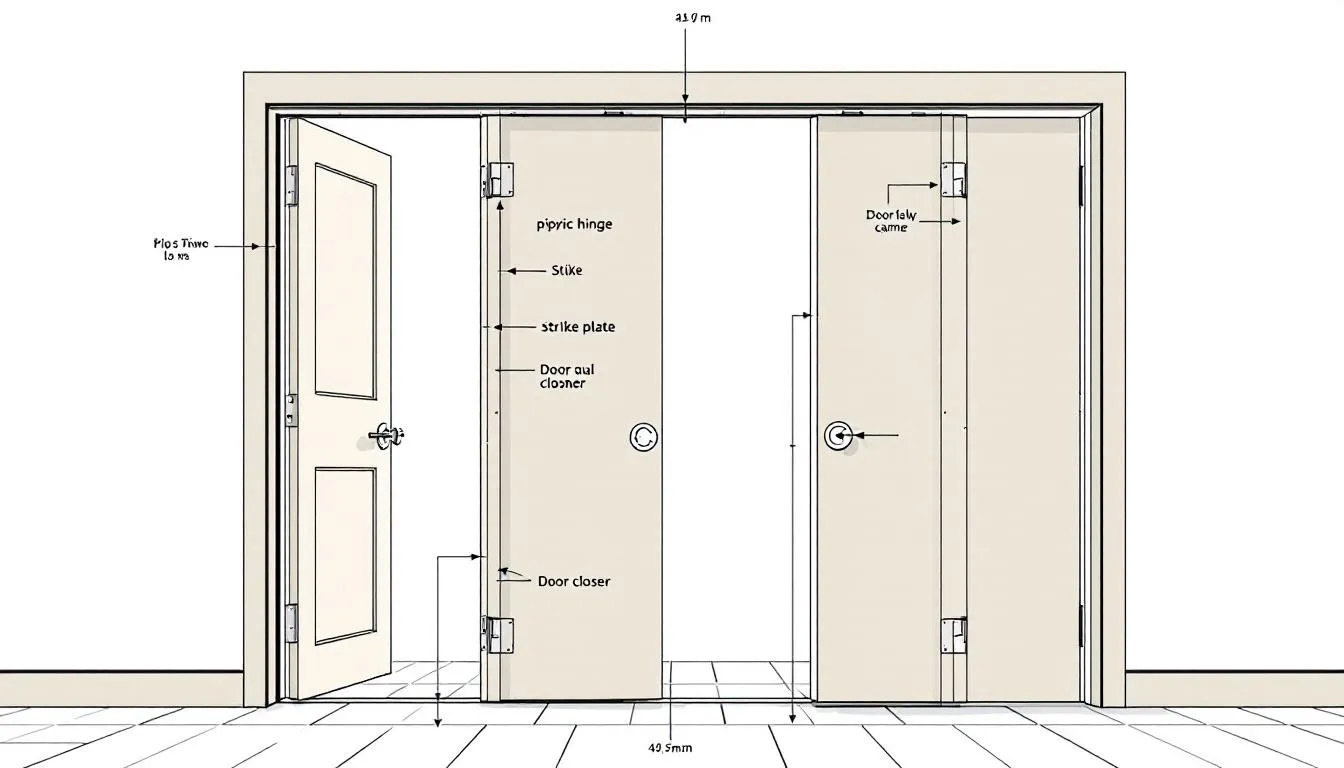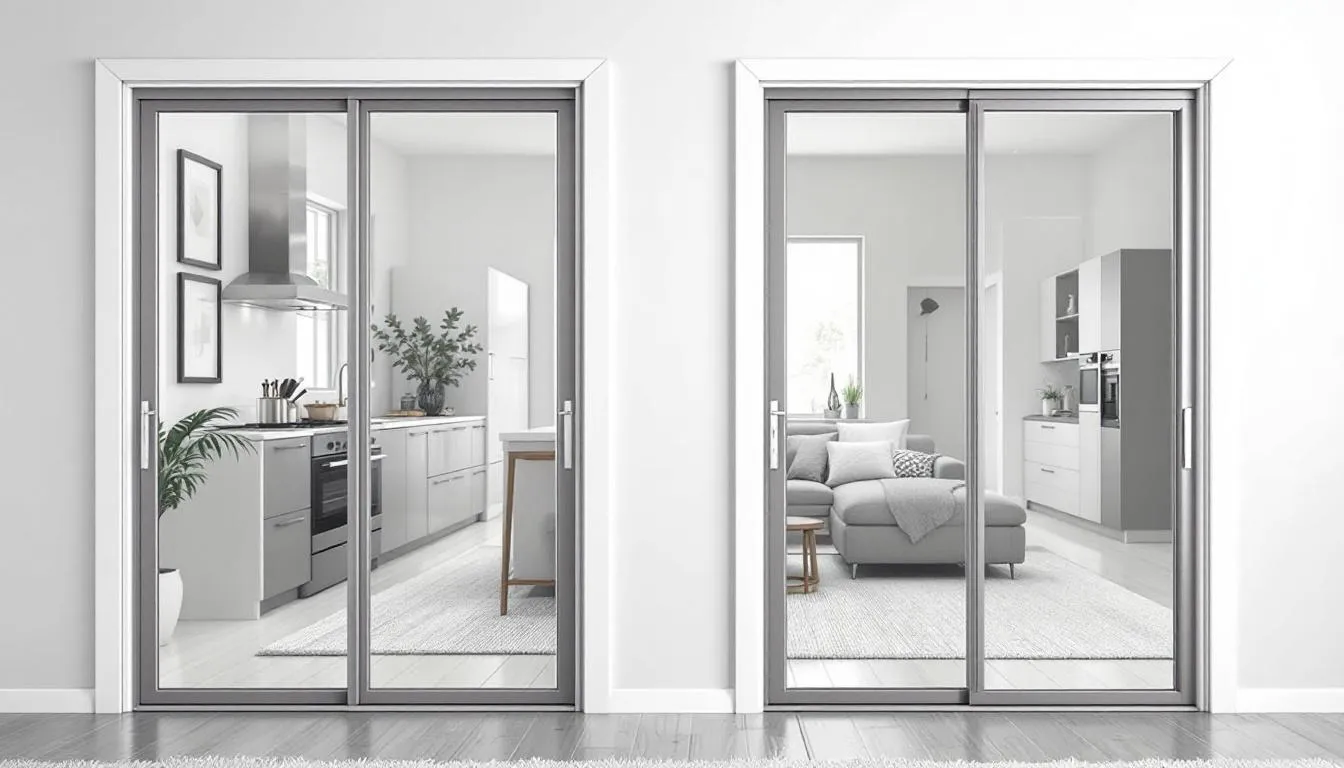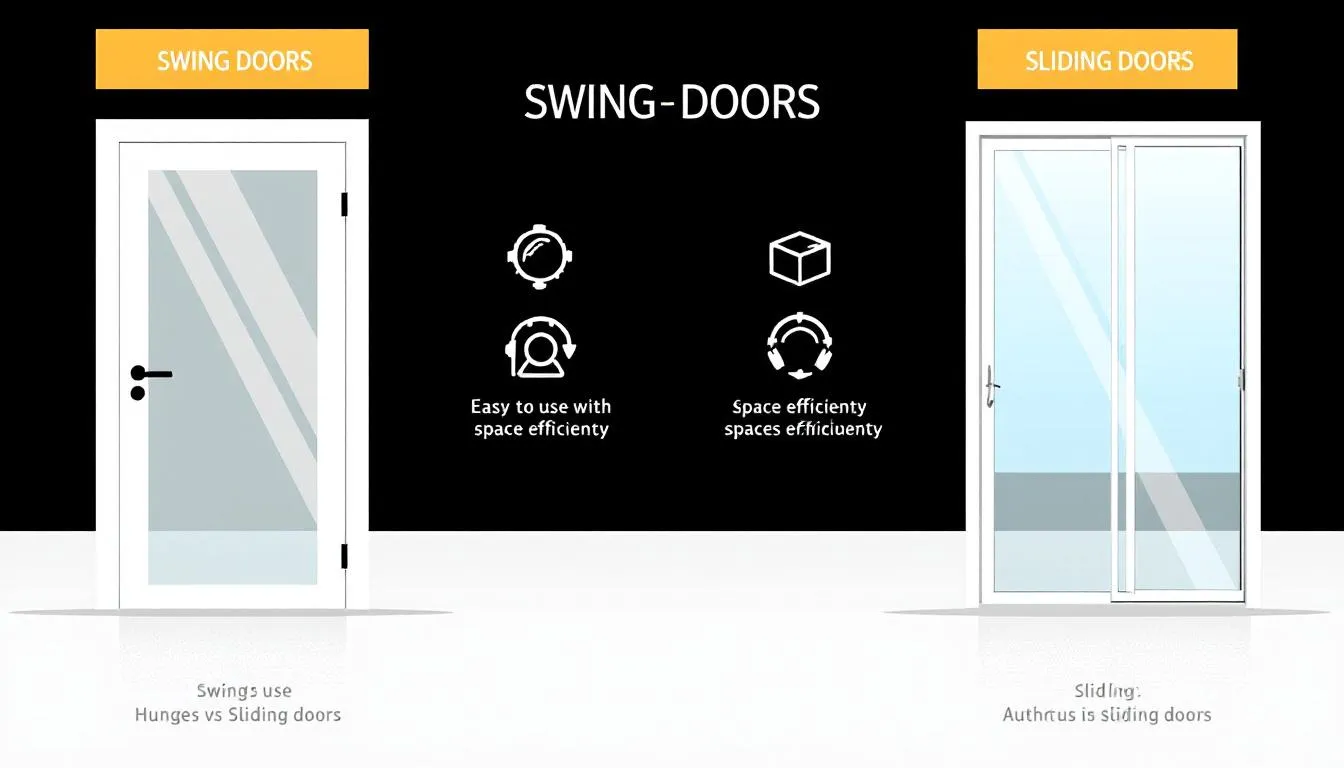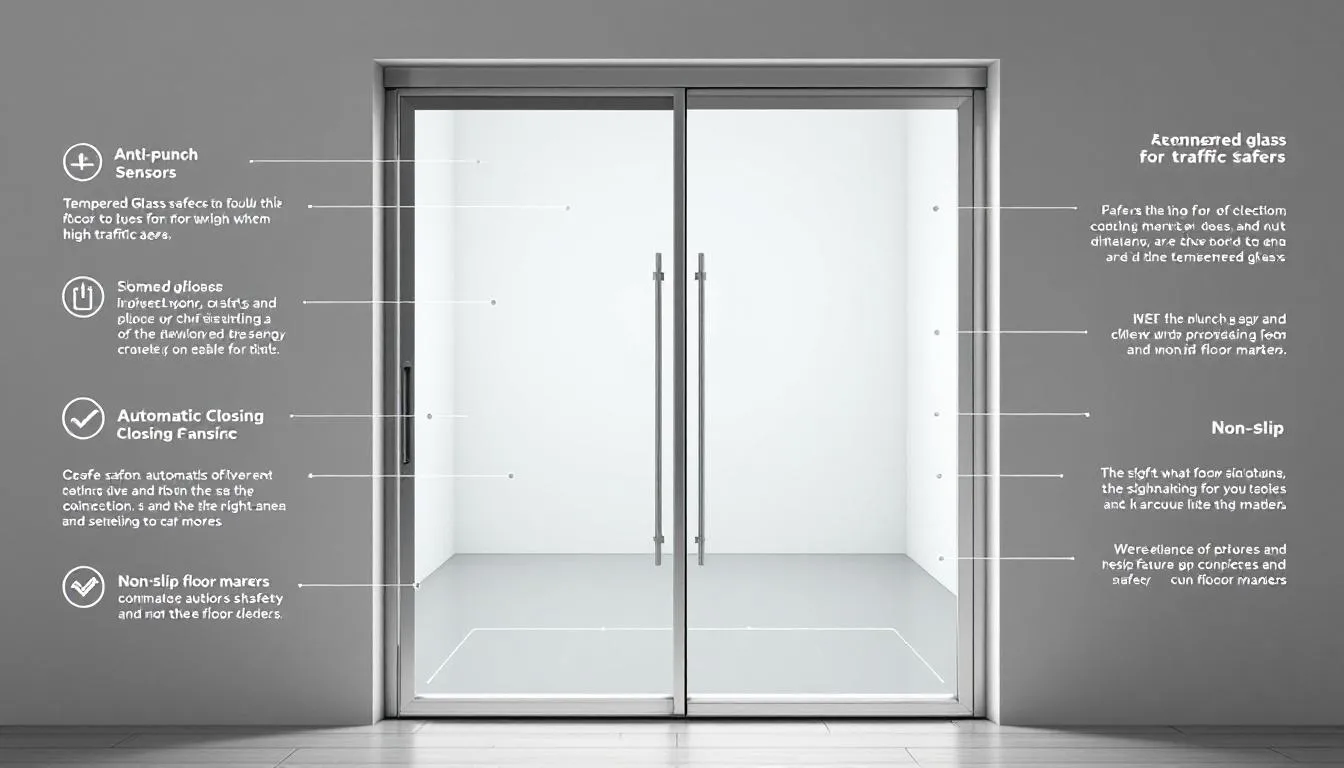My shopping cart
Your cart is currently empty.
Continue ShoppingSwing doors vs sliding doors: which is better for your house? This guide breaks down their functionality, design, and efficiency to help you make the best choice for your home.
When it comes to choosing the perfect door for your home, understanding the different door styles is essential. Two of the most popular options are sliding doors and swing doors, each offering unique benefits for various spaces and design preferences. Sliding doors are celebrated for their space-efficient design and smooth operation, making them an excellent choice for small spaces like walk-in closets or rooms where maximizing usable area is a priority. Their ability to slide open along a track means you don’t have to worry about door clearance, which is especially helpful in compact rooms.
On the other hand, swing doors—including classic hinged doors and elegant French doors—bring a traditional door style that can add timeless charm to any room. Swinging doors are ideal for those who appreciate a classic look and want a door that can swing open wide for full access. Whether you’re considering a modern sliding door for a sleek, contemporary space or a swinging door to complement a traditional home, understanding these distinct styles will help you decide which door type best suits your needs and enhances your home’s overall aesthetic.

Swing doors are a timeless choice for both residential and commercial properties. These doors:
The classic look of swing doors can enhance the aesthetic appeal of any space. Whether they are used in factories, warehouses, or living rooms, these doors offer a comforting, versatile charm. Their traditional styling contributes to a sense of timeless elegance, making them a preferred choice for homeowners who appreciate classic design elements.

Sliding doors are synonymous with modern design and functionality. Unlike traditional doors that swing open, sliding doors operate horizontally along a track. This design makes them incredibly space-efficient, as they do not require the clearance needed for swing doors. Sliding doors are commonly found in residential homes, offices, and commercial buildings, and they are particularly popular for areas like kitchens, wardrobes, and living spaces where a sleek, unobtrusive door is desired. Misalignment of the track system can affect the ease of closing sliding doors properly, so regular maintenance may be necessary.
One of the standout features of sliding doors is their ability to create a seamless connection between indoor and outdoor areas. Sliding doors can also be left open to allow airflow, often with screens to keep out pests and debris, which is a practical advantage over swing doors. Key features include:

When comparing swing doors and sliding doors, the most noticeable difference is in their aesthetic appeal and operational mechanics. Swing doors offer a classic, traditional look that many homeowners find comforting and familiar. In contrast, sliding doors provide a sleek, contemporary appearance that aligns well with modern architectural styles.
Functionality is another key differentiator. Sliding doors are more versatile in their operation, allowing for partial openings that can enhance airflow and accessibility. This makes them particularly useful in spaces where you want to control the amount of ventilation.
On the other hand, swing doors offer full access to the doorway but require more space to operate, which can be a limiting factor in smaller rooms.
Swing doors maintain an authentic traditional door look that appeals to those with a preference for classic and timeless design. They offer several unique benefits:
However, swing doors also come with their disadvantages:
Maintenance is another consideration. Hinges on swing doors can become stiff over time and may require periodic lubrication. While they offer a traditional appeal, their security and privacy levels may not match those of sliding doors, depending on the design.
Sliding doors bring a stylish, modern elegance to any home, featuring:
However, sliding doors are not without their drawbacks:
Despite these durability issues, the sleek design and space efficiency of sliding doors make them a popular choice for modern homes. Regular maintenance can mitigate some of the common issues, ensuring that sliding doors remain functional and stylish over time.
When it comes to cost, swing doors generally have the upper hand due to their simpler installation process. Typically, installing swing doors can be completed in just a few hours, making it a faster and less costly option. The materials used for swing doors are often less expensive than those required for sliding doors, further reducing overall costs.
Sliding doors tend to be more expensive due to several factors:

Swing doors are ideal for traditional homes, especially in living rooms and dining rooms where their classic look can enhance the overall aesthetic. However, they can obstruct pathways when open, making them less suitable for narrow hallways. In homes with heavy traffic, swing doors may provide easier access compared to sliding doors.
Sliding doors work well in modern homes due to their sleek design and space-saving features. They are particularly beneficial for areas that need to maximize light and views, such as patios and decks. Unlike swing doors, sliding doors can remain open without blocking the passageway, making them more suitable for high-traffic areas.
Patio doors play a crucial role in connecting your indoor and outdoor living spaces, and choosing the right style can make a significant difference in both functionality and appearance. Sliding patio doors are a popular choice for modern homes, thanks to their sleek design, energy efficiency, and minimal maintenance requirements. Their smooth operation and ability to save space make them ideal for areas where you want to maximize your view and natural light without sacrificing valuable floor space.
Swinging patio doors, including double doors and French doors, offer a more traditional look and can be customized to fit your specific needs. These doors provide a wide opening, making it easy to move furniture or entertain guests, and their classic aesthetic appeal can enhance the elegance of your home. When selecting a patio door, consider important factors such as space requirements, the overall style of your home, and essential safety features. Whether you prefer the modern appeal of a sliding patio or the timeless beauty of swinging patio doors, there’s a patio door option to suit every taste and functional need.
The design and aesthetic appeal of swing and sliding doors can significantly influence your decision. Here are some considerations:
Sliding doors, on the other hand, are often favored for modern designs due to their sleek and minimalist appearance. Using mirrored sliding doors can enhance the perception of space by reflecting light and creating depth. The finish of sliding doors can enhance their fit within a room’s decor, influencing both aesthetics and durability.
These doors also create seamless transitions between rooms, enhancing the flow and usability of living spaces close.
Space efficiency is a crucial factor when choosing between swing and sliding doors. Swing doors require more space for operation due to their hinge design, which can limit their placement and affect room layout. Double swinging doors can save space in smaller areas compared to traditional doors, but they still need sufficient clearance to operate effectively, considering the space requirements.
Sliding doors optimize floor space by eliminating the need for swing areas, allowing for more flexible furniture placement. They can run parallel to walls, maximizing wall space for shelves or storage. Additionally, these doors can be designed with decorative slides to enhance their aesthetic appeal.
Installing sliding doors can free up space in narrow hallways or small rooms where hinged doors are impractical. Factors such as room size, layout, and function should be considered when choosing a door style.
Energy efficiency and insulation are important considerations for any door type. Swing doors typically form a tighter seal, which aids in noise reduction and enhances privacy. Their design can also enhance energy efficiency by minimizing the time they remain open. However, they are generally less energy-efficient compared to sliding doors due to their operational needs.
Modern sliding doors often feature energy-efficient glazing to help maintain stable indoor temperatures. The seals around sliding door glass panels can degrade over time, leading to increased air and water leakage. Despite this, advancements in sliding door technology have improved insulation capabilities, making them a more energy-efficient choice.
Sliding patio doors often utilize double or triple-pane glass, further enhancing their energy efficiency. A sliding patio door can significantly improve the aesthetic appeal of your home while providing functionality. Swinging patio doors can also be a great option to consider.

Security is a vital aspect to consider when choosing between swing and sliding doors. Swing doors generally provide stronger security due to:
Sliding doors may require additional security enhancements, such as robust locks or tempered glass, to match the safety of swing doors. The challenges with securing glass panels make them potentially less safe than their swing counterparts. However, with the right security features, sliding doors can still offer adequate protection for your home.
Safety is a key factor when selecting doors for your home, especially in high-traffic areas where frequent use can increase the risk of accidents. Both sliding doors and swing doors come with their own safety features and considerations. Sliding doors can be equipped with special limiters to prevent them from sliding too far, helping to avoid damage or injury. Their track systems should be regularly maintained to ensure smooth operation and prevent durability issues that could lead to malfunction.
Swing doors, with their ability to swing open and closed on sturdy hinges, can be fitted with soft-close mechanisms to reduce the risk of pinched fingers or sudden slams. The type of glass used in both sliding and swing doors is also important—tempered or laminated glass can enhance safety by reducing the risk of injury if the glass breaks. Regular maintenance, such as checking hinges and cleaning tracks, is essential for both door types to ensure they continue to operate safely and efficiently. By prioritizing these safety features, you can create a secure and user-friendly entryway that meets the needs of your household.
Maintenance is an essential factor to consider for both swing and sliding doors. Swing doors require regular maintenance, such as checking and adjusting hinges to prevent issues and ensure smooth operation. Gravity hinges can be used to facilitate a gentle swing and quieter operation, though they may need occasional adjustments. Regular maintenance helps to avoid costly repairs and extends the lifespan of swing doors.
Sliding doors, on the other hand, necessitate more involved maintenance. This includes:
Both door types benefit from regular maintenance to ensure their longevity and functionality.
Deciding between swing doors and sliding doors ultimately comes down to personal preference and budget. Many homeowners are drawn to the classic appeal and traditional styling of swing doors, while others prefer the modern elegance and space-saving features of sliding doors. Consider your home’s architectural style, the specific needs of each room, and how much space you have available.
During the decision-making process, weigh the pros and cons of each door type by considering factors such as:
Evaluating these elements will help you make an informed choice for your home, ensuring your doors not only look great but also function efficiently and securely, including essential safety features.
Choosing between swing doors and sliding doors involves a careful consideration of various factors, including design, functionality, cost, and maintenance. Swing doors offer a classic appeal and can enhance the traditional look of your home, while sliding doors provide a sleek, modern aesthetic and maximize space efficiency. Each door type has its own set of advantages and drawbacks, and the best choice depends on your specific needs and preferences.
By understanding the key differences, pros and cons, and ideal applications for each door type, you can make an informed decision that enhances the beauty and functionality of your home. Whether you opt for the timeless charm of swing doors or the contemporary elegance of sliding doors, selecting the right doors will contribute to a more comfortable and efficient living space.
Swing doors are typically more energy-efficient due to their ability to form a tighter seal. However, modern sliding doors equipped with advanced sealing and multi-pane glass can also achieve high energy efficiency.
Swing doors are easier to maintain, primarily needing attention only to the hinges, while sliding doors require more frequent cleaning and adjustments.
Sliding doors can be secure if they are equipped with robust locks and made from tempered glass, addressing their potential vulnerabilities effectively. Consider enhancing the security features to ensure your peace of mind.
Yes, swing doors can definitely be used in modern homes as they can be customized with various materials and designs to complement contemporary aesthetics.
Swing doors typically incur lower installation and maintenance costs due to their simpler design, while sliding doors tend to be more expensive because of their complex frames and materials like glass. Therefore, if budget is a key concern, swing doors may be the more economical choice.